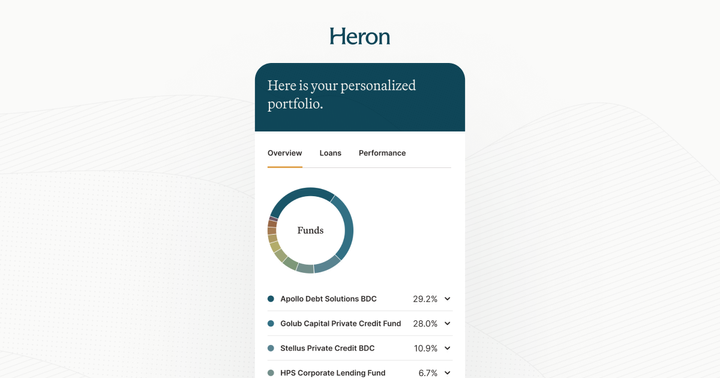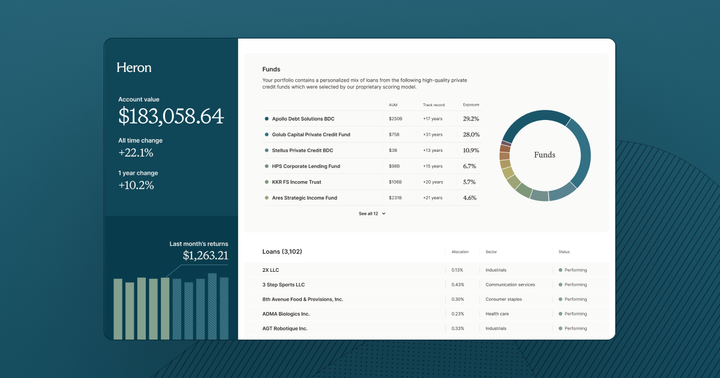Our Approach to Liquidity
Heron Finance seeks to improve liquidity for its investors. This article explores our approach to liquidity, redemptions and lockup periods.

One of the primary reasons private credit investments historically have been limited to institutional investors and high-net-worth individuals is because the asset class is relatively illiquid, in comparison to publicly-traded stocks and bonds. In typical private credit deals, investors are often subject to lengthy lock-up periods that may range from two to five years. For the largest institutional investors such as mutual funds, pension plans, and insurance companies, locking up capital for extended periods of time may be advantageous; however, for smaller investors that may need shorter-term access to their capital, a two to five year lock-up period is often untenable.
We recognize that liquidity is an extremely important topic for our clients, and in this post we describe our approach to liquidity, what that means for you, and what we do to improve liquidity in comparison to other private credit investment opportunities.
Private Credit is Inherently Illiquid
Before we discuss our approach to liquidity, we need to emphasize from the beginning: private credit as an asset class has unique liquidity characteristics that distinguish it from traditional fixed-income investments like publicly-traded bonds. The illiquidity of private credit is a crucial aspect for investors to understand, as it directly impacts the flexibility and risk profile of their investments. This illiquidity arises from several intrinsic and market-related factors, which are essential to consider when evaluating private credit as part of a diversified investment portfolio.
- Nature of Private Credit Instruments: Private credit typically involves lending to companies outside of traditional banking channels and public markets. These loans are often tailored to specific borrower needs and lack a standardized structure, making them inherently less liquid. Unlike publicly-traded bonds, private credit instruments are not listed on an exchange, leading to a limited secondary market. The bespoke nature of these loans, coupled with the absence of a standardized trading platform, makes it more challenging for investors to quickly buy or sell these assets.
- Limited Investor Base and Information Asymmetry: Private credit markets generally attract a smaller, more specialized investor base compared to public debt markets. This limited pool of potential buyers and sellers reduces the frequency of transactions, contributing to lower liquidity. Additionally, private credit transactions often involve a higher degree of information asymmetry. Lenders have access to detailed private information about the borrowers, which is not readily available to outside investors. This lack of transparency can deter potential buyers, further reducing the liquidity of these assets.
- Longer Investment Horizons and Restrictive Covenants: Private credit investments are typically characterized by longer maturities and investment horizons. Borrowers in these markets often seek capital for medium to long-term projects, leading to extended loan terms. Furthermore, these loans may include restrictive covenants and prepayment penalties that deter early exits, aligning the interests of borrowers and lenders over a longer period. While this structure can offer higher returns and more stable cash flows, it also means that investors in private credit are usually committed for the duration of the loan, resulting in reduced liquidity.
- Market Dynamics and Regulatory Factors: The private credit market is also influenced by broader market dynamics and regulatory factors. For instance, regulatory changes can impact banks’ lending practices, subsequently affecting the flow of capital into private credit markets. In times of economic uncertainty or market downturns, the appetite for riskier assets like private credit diminishes, leading to a further decrease in liquidity. Moreover, private credit often involves dealing with smaller or niche companies whose financial health might be more susceptible to economic shifts, adding to the illiquidity risk as investors become more cautious in such environments.
Our Withdrawal Policy in Plain English
We are committed to offering our clients an exceptional experience, designed to provide greater flexibility and access to the private credit market. With respect to liquidity, our goal is to process withdrawal requests as efficiently as possible, with the aim of returning client funds within a quarter, subject to available liquidity. It is important to note that we cannot guarantee redemption on a quarterly basis, and there can be instances where the process may take longer. However, within one quarter is our target, and we work very hard to expedite this process wherever feasible.
Key aspects of our liquidity policy include:
- There are zero penalties or fees for redemption.
- There are no lockup periods, which means clients may request redemption at any time on a quarterly basis.
- Our goal is to process all withdrawal requests within one quarter, subject to available liquidity.
- It is important to note that we cannot guarantee redemption within the quarter.
- There may be instances where one of the funds that Heron provides exposure to suspends redemption during a given quarter, delaying a withdrawal.
We aim to provide efficient processing of redemption requests, and if we anticipate a delay in fulfilling a request beyond one quarter, we will proactively notify our clients.
Finally, it is important to be aware that Heron Finance reserves the right to modify the liquidity policy. Should there be any material changes to our policy, we will ensure all our clients are promptly informed of these adjustments. This policy underscores our commitment to maintaining transparency and safeguarding our clients’ interests in varying market conditions.




